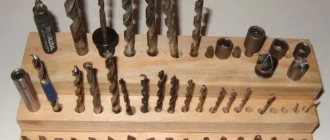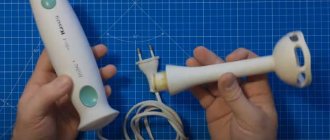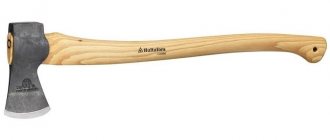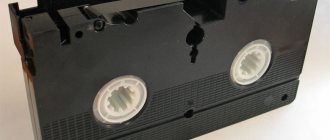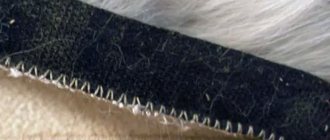A true craftsman always makes file handles with his own hands. But then why are files sold without handles? I bought three files at the market and decided to make the handles myself from old licked upside-down screwdrivers. I have a lot of such goodness... I rummaged around in my workshop and found three pieces. Friends, don’t throw away your old screwdrivers, you will still need them.
To work, we will need a plastic screwdriver handle, a hot glue gun and ten minutes of free time. Fill the handle with hot melt glue.
To ensure that the file adheres well, heat the file shank with a hair dryer at maximum speed for two minutes.
Insert the file into the handle and add hot glue if necessary. Then wait for the glue to harden.
That's all! The result was a file with a plastic handle made from an old screwdriver. The handle stuck very firmly to the file.
In this way I glued two more handles to the files. In the end, I ended up with three files with plastic handles made from old screwdrivers with my own hands.
Friends, I wish you good luck and good mood! See you in new articles!
The basis for the homemade project will be a golf ball. And the things will turn out not only necessary and practical, but also stylish. All details with step-by-step instructions and photos are attached.
Tutorial #1: Screwdriver handle with golf ball bits
Have you ever seen an original screwdriver with a golf ball instead of a handle? We are sure not. That’s why we suggest you do it yourself.
Materials
To make a screwdriver handle with your own hands, prepare:
- the screwdriver itself with interchangeable bits;
- golf ball;
- clamp;
- vice;
- drill and drill;
- stationery knife;
- rubber hammer.
Step 1
. Remove the rubber part with the attachments from the screwdriver.
Step 2
. Using a sharp utility knife, cut the rubber retainer on the plastic handle of the screwdriver. Take it off.
Step 3
. In a vice, hold the handle of the screwdriver and press lightly on it to easily remove the metal rod.
Step 4
. Select a drill bit based on the size of the screwdriver's metal shaft. The drill should be slightly smaller in diameter.
Step 5
. Drill a hole in the golf ball, but not through it. Its depth should be approximately three quarters of the diameter of the ball. For ease of use, pre-clamp the ball with a clamp or place it in a vice.
Step 6
. Using a rubber mallet, drive the metal shaft of a screwdriver into the hole of the golf ball. It should fit tightly, without wobbling or falling out.
The screwdriver is ready. It is convenient to use, and thanks to its small size, it fits easily in your hand. And don’t forget to put the bit holder on the metal rod.
Master class No. 2: DIY golf ball magnets
A golf ball can make original magnets. They will especially appeal to fans of this sport. Details of their manufacture are below.
Materials
To make your own magnets, prepare:
- large round magnets;
- golf balls;
- clamp;
- hacksaw;
- sandpaper;
- pencil;
- hot glue gun and hot glue sticks.
Step 1
. Take magnets. Using a hammer, break their plastic cases. Collect and discard their parts, remove any remaining adhesive from the surface of the magnets.
Step 2
. Take a golf ball and place it in the clamp. Using a hacksaw, carefully cut it straight down the center. You can first draw a cut line with a pencil. Use a hacksaw to saw the ball until it reaches a third of the depth, then turn the other side and continue sawing. When the deep cut extends across the entire surface of the ball, remove it from the clamp and cut to the end.
Step 3
. Sand the cuts on the two parts of the ball with sandpaper.
Step 4
. Hot glue the prepared magnets to the golf ball half.
Master class No. 3: DIY furniture handles made from golf balls
Golf balls can add style to a room. To do this, we will turn them into furniture handles.
Hello to all inventors! In today's project, we will make our own pliers, an improved screwdriver handle, and a utility knife in the form of a keychain from PVC pipes.
When heating PVC, make sure you perform this operation outdoors or wear a respirator.
A video of this project can be seen in the following footnote.
Step 1: PVC pipe crimper
I marked one side of the PVC with masking tape and then heated that side with a commercial heat gun. I then straightened the heated side using a block of wood. Next, I did the same with the other side of the PVC pipe.
I subsequently realized that this process can be made easier if you heat the entire pipe at the same time and then straighten it, instead of doing this for each side separately.
Step 2: PVC pipe crimper
I heated the middle section and bent it around another PVC pipe.
Step 3: PVC Pipe Crimper
Step 4: PVC Pipe Crimper
I heated the ends until the plastic started to melt and clamped the pipe together using a clamp.
After that I did the sanding.
Step 5: PVC Pipe Crimper
This is how we got plastic tongs. I will use them to serve ice cubes.
This item is made of plastic, so do not use it for hot foods.
Step 6: Improved Screwdriver Handle
Have you had experience making a similar item? If you use a screwdriver for a long period of time, a callus will often appear in the center of your palm. Therefore, I decided to upgrade my old screwdrivers using PVC pipe.
Screwdriver number 1
I heated up a short piece of PVC pipe and pulled it over the handle of a screwdriver. Next, I heated the other end of the tube and put it on as a cap. Heating is applied to shrink the tip so that the cap rotates freely.
The tube is removable, so if necessary, you can stretch the PVC and extend the handle (if that's what you want to do). The cap will rotate and prevent calluses from forming on your palm.
Step 7: Improved Screwdriver Handle
Screwdriver number 2
I heated up the T-piece and pulled it onto the handle. If necessary, you can connect a T-piece to provide the best possible girth.
Step 8: Keychain Utility Knife
I heated up a short piece of PVC pipe and compressed it using a clamp. Next, I inserted the blade and squeezed the clamp even tighter.
Step 9: Keychain Utility Knife
I cut two separate blanks from plastic beading plate and glued them to the jaws of the clamp.
Step 10: Keychain Utility Knife
I used a clamp to create a dotted pattern.
Step 11: Keychain Utility Knife
When the PVC pipe is reheated, it will return to its original shape. That's why I used a candle, because it makes it more convenient to control this process.
I heated both sides of the pipe and closed them using a clamp. One of the ends was closed with a knife blade inside.
Step 12: Keychain Utility Knife
I pulled out a knife blade and made a lid from a larger PVC pipe.
Step 13: Keychain Utility Knife
I drilled a hole in the lid and did some final sanding.
Step 14: Keychain Utility Knife
Now your universal knife in the form of a keychain is completely ready.
The knife blade is held in place by the downward pressure of your fingers. An excellent knife for opening packages and many other tasks.
The knife is very sharp, so be careful.
If you accidentally get into an accident and your seat belt gets tangled, then by all means, use this utility knife.
In this short video tutorial, blogger Serega Otvertka explained how to make a screwdriver from a simple nail. To make this simple but necessary tool with your own hands, you will need a small wooden block and a 150 mm nail. The length of the bar is approximately 10 centimeters. On the sides of the wooden blanks you need to make marks along which the rounding will be made. We measure 1 centimeter at the back and 1.5 centimeters at the front.
On the back side you need to round the edges well with a file, on the other side you need to make hollows. For comfortable holding in your hands, you will need to make small notches using a chisel, as is usually done on factory screwdrivers.
When the workpiece is ready, you need to work on the nail. You need to cut off the cap and flatten one end. This can be done using a hammer and anvil. You need to drill a hole in the handle, insert a nail there and secure it with epoxy resin.
It is convenient to use a vice. We heat the nail and tap it with a hammer, giving it the desired shape. Naturally, all this will need to be processed with a metal file. That is, you need to align the edges and make a small tip of the sting.
The tip of the nail must be sanded and hardened. The tip is heated red-hot and dropped into cold sunflower or machine oil. The result is a hardening with a slight blue tint. After drilling a hole in the wooden handle, insert the tip inside to a depth of about 5 centimeters. The side of the nail that will be inserted into the piece of wood needs to be wrapped in a bandage, coated with epoxy resin and pressed into the handle.
After the epoxy has dried, we clean everything with fine sandpaper and coat the handle with colorless varnish. Before this, you can do a small decorative firing of the handle.
A homemade screwdriver does its job perfectly. The advantages of this method are that you can make screwdrivers of the desired size, the desired configuration, and you can vary the length of the handle and blade. And, most importantly, it is creativity!
Handle for screwdriver made of epoxy and self-tapping screws in bookmarks 2
There was a similar article about a handle made from shell casings earlier, but this master uses a slightly different pouring technique.
Materials. – Two-component epoxy resin – Sandpaper – Abrasive polishing paste – Screwdriver – Masking tape – Self-tapping screws or screws.
Tools used by the author. – Lathe – Chisels – Glue gun.
Manufacturing process. So, the author collected some self-tapping screws, a screwdriver with a not very aesthetic handle, and plastic for formwork.
He will also use this two-part epoxy resin.
Then he makes the formwork using a glue gun. Before pouring, it is advisable to treat its edges with a separator for ease of disassembly, but the author decides not to do this. Once the resin hardens, it will simply break the plastic.
Mixes both components of epoxy resin and fills a third of the height of the future form. This is necessary so that the screws remain inside the handle and do not protrude beyond it.
The next day, after the first layer has hardened, lay screws on it, and pour a second layer twice as thick as the first. Then he collects all the screws in the central part and leaves it for another day.
Fixes the workpiece on the lathe and begins processing. First, he flattens it to a cylindrical shape. At all stages of turning work, it is extremely important not to overheat the workpiece. When overheated, epoxy resin loses its strength and becomes brittle. And certain brands of resins can change color and turn yellow.
After this, you can set the handle to the required profile.
A chip has formed at the lower end of the workpiece; it will have to be ground off and the upper part of the handle cut.
Next comes the sanding step, starting with P100 sandpaper and up to P600. Final sanding is done with the addition of water using P1000 paper.
Now comes the polishing stage with abrasive paste. In the post-Soviet space, GOI paste is used.
All that remains is to drill a hole for the screwdriver.
And, protecting the finished handle with masking tape, glue a screwdriver into it.
That's all, it turns out to be a very unusual screwdriver handle.
Thanks to the author for a simple but interesting way to improve the appearance of the instrument!
see also
Comments 64
This is what every mechanic at the factory did!
Beauty! I watched all the videos! Work with soul and love!
For me it's the invention of the wheel
Using a flow cutter we remove the excess that would be more correct to cut off with a cut-off cutter, and with a cut-off cutter we sharpen the parts, everything is logical.
wow what passions
